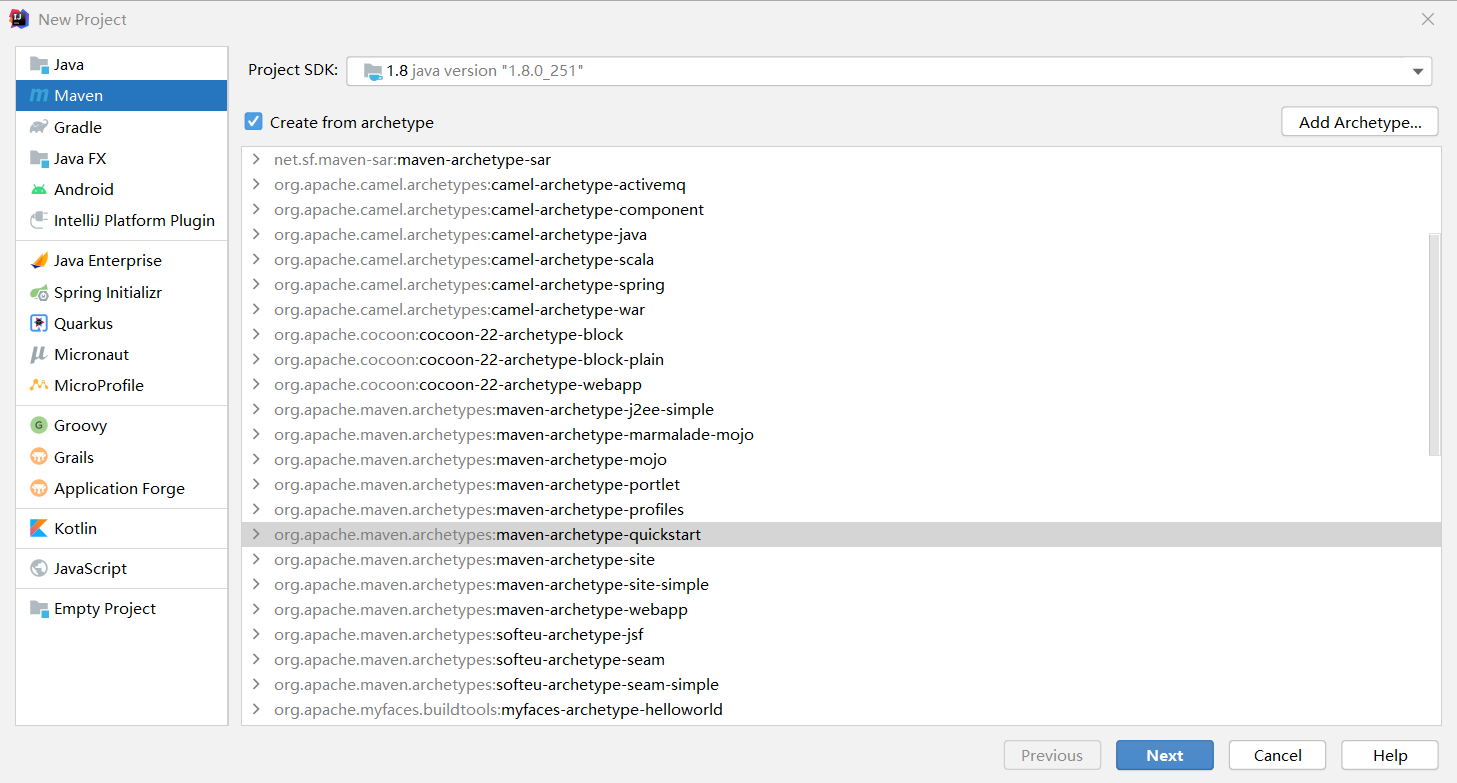背景
公司的物流业务系统目前实现了使用storm集群进行过门事件的实时计算处理,但是还有一个需求,我们需要存储每个标签上传的每条明细数据,然后进行定期的标签报表统计,这个是目前的实时计算框架无法满足的,需要考虑离线存储和计算引擎。
标签的数据量是巨大的,此时存储在mysql中是不合适的,所以我们考虑了分布式存储系统HDFS。目前考虑的架构是,把每条明细数据存储到HDFS中,利用Hive或者其他类SQL的解析引擎,定期进行离线统计计算。
查找相关资料后,我下载了深入理解Haddoop这本书,从大数据的一些基础原理开始调研,这一系列的笔记就是调研笔记。
系列文章:
深入理解Hadoop-基础部分
这篇笔记主要是参考慕课网的 Hadoop3基础与电商行为日志分析 新手也能学会的大数据入门课这门课程,之所以加入基础部分,是因为跟着书籍目录在搭建好Linux下的Hadoop的运行环境后,继续往下看书时,发现在IDEA部分卡住了,所以回过头参考视频来学习如何使用IDEA开发,以及学习HDFS的API和MapReduce的一部分API,通过实操简单入门。
1. HDFS的API使用
深入理解Hadoop读书笔记2](https://www.cnblogs.com/ging/p/13565645.html)中讲解过Hadoop在Linux环境下的部署,在虚拟机中安装好Hadoop后,我们需要使用IDEA来进行开发调试。
下面会讲解Linux下使用IDEA,通过HDFS的JAVA API,来连接并操作虚拟机中的HDFS创建一个文件夹的具体过程。
IDEA的安装和破解这里略过,默认读者是有一定JAVA开发经验的。
安装好IDEA后,新建一个maven的项目,这里选择下面的quickstart模板。

建立好项目后,修改pom文件,增加hadoop-client相关,因为我虚拟机中安装的是2.10.0版本,所以这里也使用相同的客户端版本。
<dependency>
<groupId>org.apache.hadoop</groupId>
<artifactId>hadoop-client</artifactId>
<version>2.10.0</version>
</dependency>
然后建立一个Class文件,添加下面的代码,即可实现,远程连接HDFS并在其中新建一个路径为/hdfs/test的文件夹。
这里有几个要点需要注意:
-
HDFS进行伪分布式部署的时候,core-site.xml中填写的是localhost,现在需要修改为虚拟机的ip地址,否则使用下面代码连接HDFS时会报下面的异常。
failed on connection exception: java.net.ConnectException:Connection refused<configuration> <property> <name>fs.defaultFS</name> <value>hdfs://192.168.202.129:9000</value> </property> </configuration> -
用户名需要填写为HDFS中的文件夹拥有者的用户名
用命令查看下可知,文件夹的所有者为ging
ging@ubuntu:~/hadoop/hadoop-2.10.0$ bin/hdfs dfs -ls / Found 3 items drwxr-xr-x - ging supergroup 0 2020-09-01 23:47 /hdfs drwx------ - ging supergroup 0 2020-08-30 20:26 /tmp drwxr-xr-x - ging supergroup 0 2020-08-30 20:27 /user
完整代码如下:
package org.example;
import org.apache.hadoop.conf.Configuration;
import org.apache.hadoop.fs.FileSystem;
import org.apache.hadoop.fs.Path;
import java.net.URI;
public class HDFSApp {
public static void main(String[] args) throws Exception {
//注意URI中为虚拟机中的HDFS的地址和端口
FileSystem fileSystem = FileSystem.get(new URI("hdfs://192.168.202.129:9000"), new Configuration(), "ging");
//给定一个路径,新建一个文件夹,并打印返回结果
boolean result = fileSystem.mkdirs(new Path("/hdfs/test"));
System.out.println(result);
}
}
返回结果:
Connected to the target VM, address: '127.0.0.1:59339', transport: 'socket'
true
Disconnected from the target VM, address: '127.0.0.1:59339', transport: 'socket'
除了上面用来演示讲解的创建文件夹功能,下面的代码还记录了,常用的基本HDFS的JAVA API,可以参考
package org.example;
import org.apache.hadoop.conf.Configuration;
import org.apache.hadoop.fs.FileSystem;
import org.apache.hadoop.fs.*;
import org.apache.hadoop.io.IOUtils;
import org.apache.hadoop.util.Progressable;
import org.junit.After;
import org.junit.Before;
import org.junit.Test;
import java.io.*;
import java.net.URI;
/**
* Unit test for simple App.
*/
public class AppTest {
public static final String HDFS = "hdfs://192.168.202.129:9000";
private Configuration configuration;
private FileSystem fileSystem;
@Before
public void setUp() throws Exception {
System.out.println("---setup---");
configuration = new Configuration();
fileSystem = FileSystem.get(new URI(HDFS), configuration, "ging");
}
@Test
public void mkdirs() throws IOException {
boolean result = fileSystem.mkdirs(new Path("/hdfs/test/test"));
System.out.println(result);
}
@Test
public void text() throws Exception {
FSDataInputStream inputStream = fileSystem.open(new Path("/user/ging/input/core-site.xml"));
IOUtils.copyBytes(inputStream, System.out, 1024);
}
@Test
public void create() throws Exception {
FSDataOutputStream outputStream = fileSystem.create(new Path("/hdfs/test/test/a.txt"));
outputStream.writeUTF("hello world");
outputStream.flush();
outputStream.close();
}
@Test
public void rename() throws Exception {
Path oldPath = new Path("/hdfs/test/test/a.txt");
Path newPath = new Path("/hdfs/test/test/b.txt");
boolean rename = fileSystem.rename(oldPath, newPath);
System.out.println(rename);
}
@Test
public void copyFromLocal() throws Exception {
Path local = new Path("C:\Users\wgg96\Documents\personal-code\suanfa-note\CMakeLists.txt");
Path remote = new Path("/hdfs/test/test/c.txt");
fileSystem.copyFromLocalFile(local, remote);
}
@Test
public void copyBigFileWithProgress() throws Exception {
InputStream inputStream = new BufferedInputStream(new FileInputStream(new File("C:\Users\wgg96\Documents\安装包\开发\jdk-8u251-windows-x64.exe")));
FSDataOutputStream outputStream = fileSystem.create(new Path("/hdfs/test/test/d.exe"), new Progressable() {
@Override
public void progress() {
System.out.print(".");
}
});
IOUtils.copyBytes(inputStream, outputStream, 4096);
}
/**
* TODO 这里在windows系统下跑会报异常
*
* @throws Exception
*/
@Test
public void copyToLocal() throws Exception {
fileSystem.copyToLocalFile(new Path("/hdfs/test/test/d.exe"), new Path("/tmp/d.exe"));
}
@Test
public void listFile() throws Exception {
FileStatus[] fileStatuses = fileSystem.listStatus(new Path("/hdfs/test/test/"));
for (FileStatus fileStatus : fileStatuses) {
String isDir = fileStatus.isDirectory() ? "文件夹" : "文件";
String permission = fileStatus.getPermission().toString();
short replication = fileStatus.getReplication();
String owner = fileStatus.getOwner();
String group = fileStatus.getGroup();
String path = fileStatus.getPath().toString();
System.out.println(isDir + " " +
permission + " " +
replication + " " +
owner + " " +
group + " " +
path + " "
);
}
}
@After
public void tearDown() {
configuration = null;
fileSystem = null;
System.out.println("---teardown---");
}
}
2. MapReduce的API使用
这部分内容,是使用MapReduce编写了一个词频统计任务,代码中使用了两种模式
- 输入输出使用HDFS -对应了APP
- 输入输出使用本地路径模式 -对应了APPLocal
核心代码如下
Mapper
package org.example;
import org.apache.hadoop.io.IntWritable;
import org.apache.hadoop.io.LongWritable;
import org.apache.hadoop.io.Text;
import org.apache.hadoop.mapreduce.Mapper;
import java.io.IOException;
/**
* LongWritable:偏移量
* Text:每一行的字符串
* Text:单词
* IntWritable:单词词频,map阶段,默认为1
*/
public class WordCountMapper extends Mapper<LongWritable, Text, Text, IntWritable> {
@Override
protected void map(LongWritable key, Text value, Context context) throws IOException, InterruptedException {
//分割每一行
String oriText = value.toString();
String[] strings = oriText.split(" ");
//拿到一个单词就把词频写到上下文中
for (String word : strings) {
context.write(new Text(word), new IntWritable(1));
}
}
}
Reducer
package org.example;
import org.apache.hadoop.io.IntWritable;
import org.apache.hadoop.io.Text;
import org.apache.hadoop.mapreduce.Reducer;
import java.io.IOException;
import java.util.Iterator;
/**
* Text:词频统计中的每一个单词
* Iterable<IntWritable> : 词频统计中对应的多个1,可以理解成一个列表
* Text:输出每一个单词
* IntWritable:每个单词的总词频
*/
public class WordCountReducer extends Reducer<Text, IntWritable, Text, IntWritable> {
@Override
protected void reduce(Text key, Iterable<IntWritable> values, Context context) throws IOException, InterruptedException {
Iterator<IntWritable> iterator = values.iterator();
int finalCount = 0;
while (iterator.hasNext()) {
IntWritable intWritable = iterator.next();
finalCount += intWritable.get();
}
context.write(key, new IntWritable(finalCount));
}
}
APPLocal
package org.example;
import org.apache.hadoop.conf.Configuration;
import org.apache.hadoop.fs.Path;
import org.apache.hadoop.io.IntWritable;
import org.apache.hadoop.io.Text;
import org.apache.hadoop.mapreduce.Job;
import org.apache.hadoop.mapreduce.lib.input.FileInputFormat;
import org.apache.hadoop.mapreduce.lib.output.FileOutputFormat;
import java.io.File;
import java.io.IOException;
/**
* Hello world!
*/
public class AppLocal {
public static void main(String[] args) throws IOException, ClassNotFoundException, InterruptedException {
// System.setProperty("HADOOP_USER_NAME", "ging");
Configuration configuration = new Configuration();
// configuration.set("fs.defaultFS", "hdfs://192.168.202.129:9000");
Job job = Job.getInstance(configuration);
job.setJarByClass(AppLocal.class);
job.setMapperClass(WordCountMapper.class);
job.setReducerClass(WordCountReducer.class);
//增加combiner操作
job.setCombinerClass(WordCountReducer.class);
job.setMapOutputKeyClass(Text.class);
job.setMapOutputValueClass(IntWritable.class);
job.setOutputKeyClass(Text.class);
job.setOutputValueClass(IntWritable.class);
File file = new File("/home/ging/Documents/hadoop-learn/output");
System.out.println(deleteDir(file));
FileInputFormat.setInputPaths(job, new Path("/home/ging/a.txt"));
FileOutputFormat.setOutputPath(job, new Path("output"));
boolean result = job.waitForCompletion(true);
System.out.println(result);
}
/**
* delete file
* @param src
* @return
*/
private static boolean deleteDir(File src) {
try {
if (src.isFile()) {
src.delete();
} else {
String[] list = src.list();
for (String s : list) {
deleteDir(new File(src, s));
}
src.delete();
}
return true;
} catch (Exception e) {
e.printStackTrace();
return false;
}
}
}
APP
package org.example;
import org.apache.hadoop.conf.Configuration;
import org.apache.hadoop.fs.FileSystem;
import org.apache.hadoop.fs.Path;
import org.apache.hadoop.io.IntWritable;
import org.apache.hadoop.io.Text;
import org.apache.hadoop.mapreduce.Job;
import org.apache.hadoop.mapreduce.lib.input.FileInputFormat;
import org.apache.hadoop.mapreduce.lib.output.FileOutputFormat;
import java.net.URI;
/**
* Hello world!
*/
public class App {
public static void main(String[] args) throws Exception {
System.setProperty("HADOOP_USER_NAME", "ging");
Configuration configuration = new Configuration();
configuration.set("fs.defaultFS", "hdfs://192.168.202.129:9000");
Job job = Job.getInstance(configuration);
job.setJarByClass(App.class);
job.setMapperClass(WordCountMapper.class);
job.setReducerClass(WordCountReducer.class);
//增加combiner操作
job.setCombinerClass(WordCountReducer.class);
job.setMapOutputKeyClass(Text.class);
job.setMapOutputValueClass(IntWritable.class);
job.setOutputKeyClass(Text.class);
job.setOutputValueClass(IntWritable.class);
FileSystem fileSystem = FileSystem.get(new URI("hdfs://192.168.202.129:9000"), configuration, "ging");
Path output = new Path("/hdfs/test/output");
if (fileSystem.exists(output)) {
fileSystem.delete(output, true);
}
FileInputFormat.setInputPaths(job, new Path("/hdfs/test/input"));
FileOutputFormat.setOutputPath(job, output);
boolean result = job.waitForCompletion(true);
System.out.println(result);
}
}